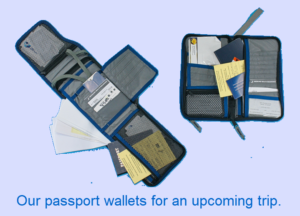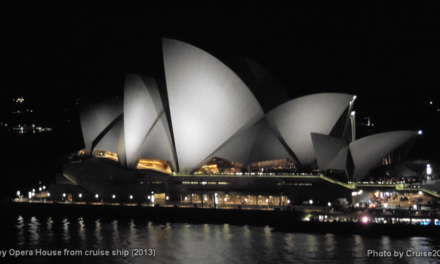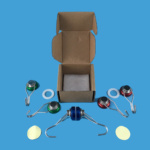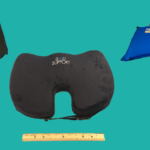It is now 2 weeks before your cruise and time to start preparing. There are a number of items you can tackle at this time to avoid the last minute panics. Since many of us have other activities (such as work) that will consume our time prior to heading out on our cruise, it is important to do as much as possible ahead of time. I have found that the 2-week mark is a good time to begin packing and preparing for the trip. Of course, there are a number of last minute items that are inevitable – I will discuss these in a separate post.
I build a checklist using Evernote so I can mark items as completed. I use an electronic checklist since I can then recycle it by unchecking the items for the next trip. The following identify some of the items I prepare one to two weeks in advance of my trip. I know there is a lot here, but this is a critical time in your planning and packing items early will take a lot of pressure off later. I am writing separate posts on many of the items below and will link them as they are written. The purpose here is to make sure you do not overlook anything.
Get travel documents in order

- Passport, if required. Verify expiration date (should be at least 6 months past the end of your trip) and blank page count (some countries require at least 5 blank full pages). Hopefully, you have done this much earlier. *
- Photocopy of passports and drivers licenses. I put copies for both of us in each wallet. *
- Global Entry card. Not required, but nice to have. This lets us skip the customs line on the return home and allows us to use TSA Pre on the departure. It also functions as a backup ID card. If you travel overseas a lot, get a Global Entry card. The United MileagePlus credit card reimburses the cost of the card, so it is free for us. *
- Vaccination record. Especially if traveling to Asia or South America, but good to have for any trip. *
- Insurance cards. Copies of Medicare, medical insurance, and dental insurance cards. I carry the cards in my wallet, but want a backup in case of an emergency.*
- Address cards. For handing out to people I meet and want to stay in contact with. I print these out on Avery card stock, but you can print on regular paper and just cut them off. Your word processing software should have a template for printing these. I will write more on this later. *

- Return address labels. I save the labels I receive in the mail and use them for identification stickers. I put these on items I carry for identification and use them on luggage tags that are required when leaving the ship. This saves me from writing out the information multiple times. *
- Spare cash. We generally take about $300 in cash for a 2-week cruise. Some I carry on my person, the rest is split between my wife and me, in case one of us get ripped off. This is also a good time to make sure you have a supply of small bills ($1 and $5) for tips and small purchases en route. *
- Airline, hotel, and cruise itineraries. Print out a hard copy or save a copy on your mobile device. These will have the confirmation numbers and details which you will need if you encounter troubles.. Double check your airline information to confirm you have entered your frequent flyer information, your seat assignments, and your Known Traveler Number to ensure you get through security faster using TSA Pre. If you have special requirements (e.g., wheelchair or requests for room location) call the airline or hotel directly to ensure they are understood. *
- Cruise e-ticket. Put these in a location that is easy to access when you get to the ship. *
- Cruise luggage tags. Pack these where you can easily access them. You will need to apply these to your baggage before entering the ship. If you are going straight from the airport to the ship, you will need to do this at the airport. Don’t forget to apply the address labels so your personal information is on the tag – much easier than writing it. I generally plan to put two tags on each checked bag in different locations in case they get torn off. I also put tags on my carry-on bags just in case I get separated from them. *
- Travel insurance cover page. This contains the basic information should we need to use the insurance. I also carry a copy of the full policy in my luggage. *
- Backup credit cards. We always carry a backup credit card in case our primary card is invalidated, which happened to us during one cruise when our credit card company suspended the card due to perceived fraud. Keep in mind that, when travelling internationally, not all credit card brands are accepted everywhere. We have found Visa to be the best, but I also carry American Express and MasterCard which has served us well in the past. I put the spare cards in a metal card holder (anti-RFID) and carry them separate from my document wallet.
Camera and Electronics gear
- Cameras and related accessories. I travel with up to three cameras: DSLR with telephoto lens, pocket digital camera, and a DXO iPhone attached camera. At this time, I charge all the batteries and make sure I have the accessories, such as filters, spare storage cards, and tripods. Depending on the trip, the amount of gear I take will vary. Since my cameras have Lithium Ion batteries, I pack the cameras and backup batteries in my carry-on as required by airline rules. Do not pack Lithium Ion batteries in you checked bags or they may be confiscated. Some of my accessories will be packed in my checked bags, but camera bodies and lenses always go into my carry-on.
- Electronics bag. This is what I am carrying on my next trip. Note that I will also have my charger brick and cables for devices in my personal bag, but these won’t be packed until just before my trip since I use them frequently. Check out my article on building an electronics support kit for details of the devices below.
- Chargers for camera batteries. I do carry a universal charger and have the ability to charge batteries directly in some of my cameras, but I find it useful to take the custom chargers for the batteries so I can charge multiple batteries at the same time. I take a lot of photos, so I tend to go through several batteries on a long excursion.
- General purpose battery charger. This charger can handle my AA and AAA batteries, as well as my camera batteries.
- Portable charger. This device allows me to power or charge two devices at a time. This is essential when out on long excursions with little access to power outlets. Do not assume you will be able to plug in to charge your phone or tablet.
- 4-port plug-in USB charger hub. I travel with 2 iPhones, an iPad, and 2 cameras that can be charged via USB. I also charge by portable charger (e.g., brick) so I have the ability to recharge devices in the field.
- 2-3 1 amp USB plug-in cubes. These are 1 amp or higher plug-in blocks with USB outlets. Easy to carry and very handy in a pinch.
- 2 lightning cables for iPhones and iPad. I also carry 2 additional cables with me while traveling – these are packed at the last minute since I use them every day. I find it easier to have too many cables than not enough. On more than one occasion, I have loaned a cable to other travelers who forgot theirs.
- 2 micro-USB cables for cameras and other devices. Some of my devices require a micro-USB connector to charge, so I pack two cables for these devices. I also pack a spare cable at the last minute that I carry on my person while traveling.
- Custom charger cable. I have a Nikon digital camera that has a special connector. Since I like to charge the batteries for this camera in the camera (I can use up to 4 batteries a day), I always make sure this is in my bag. You may have some devices that have special connectors. If so, make sure you pack these.
- International power adapter. I pack this on all my cruises, although it is not always necessary. Many ships have both US and European plugs. This lets me take advantage of both outlets. It is absolutely necessary when traveling outside the U.S.
- Eyeglass repair kit. Both my wife and I wear eyeglasses, so I pack an eyeglass repair kit in my electronics bag. Although this is not technically an electronic item, it is useful and I know where to find it.
- Spare batteries (AA, AAA and CR2032). Although fewer devices require AA or AAA batteries, I do pack spare batteries. I tend towards rechargeable batteries as a matter of convenience. I am finding that the CR2032 button batteries are becoming more useful as many devices now use these batteries. If you carry items that require other battery sized, consider carrying spares.
- Spare glucose meter. I am a diabetic, so I pack by backup glucose meter in my electronics bag. My primary meter is carried with me while I travel.
Medications and toiletries
- Medicine bag. I have a separate bag into which I pack my pills and any over the counter medications. This is a good time to refill any medications that may run out.

- Daily medications in 1-week pill cases. I have four 1-week pill organizers that can be packed for long trips. The pill cases I use have AM and PM chambers, but the configuration should match your specific requirements. The number of cases I pack is dependent on the length of the trip. But I always try to take 3-4 days extra in case there are any unexpected delays.
As an added protection, put pill cases in a Ziploc bag in case one of the compartments pops open from all the bag handling.
- Prescription medications not in the pill cases. I have some pills I must take at specific times that do not align with my AM/PM schedule. I keep these in their original pill bottles or pack them in smaller containers that are properly labeled.
- Over the counter medications (e.g., Advil, NyQuil, Cough Drops, etc.). These I put in small bottles to take less space and label the bottles with a sharpie so I know what they are.
- Diabetes supplies. Since I am diabetic, this is important. I make sure I have my glucose meters, sufficient test strips and lancets, and my injectable medications. I also carry a supply of glucose tablets in several locations. This is a specialty need, but I have found that many cruisers are diabetic and know from experience that controlling one’s glucose level on a cruise can be difficult.
- Daily medications in 1-week pill cases. I have four 1-week pill organizers that can be packed for long trips. The pill cases I use have AM and PM chambers, but the configuration should match your specific requirements. The number of cases I pack is dependent on the length of the trip. But I always try to take 3-4 days extra in case there are any unexpected delays.
- Toiletry bag. Since we travel a lot, I keep this bag prepared at all times. The only requirement I have prior to a trip is to make sure I am not running low on something. Since I pack the toiletry bag in my checked bag, I don’t need to worry about the liquid restrictions. The following are items I have in my toiletry bag.
- Toothpaste and mouthwash. The size depends on the length of the trip.
- Toothbrush. I will pack my electric toothbrush as a last minute item, but always carry a standard toothbrush just in case.
- Brush, comb, and hair products. What you carry will depend on your hair care requirements.
- Grooming kit. This is a cheap kit I got a long time ago. It contains clippers, files, scissors, tweezers, and several other items. This comes in handy when I break a nail or for long cruises where I need to trim my nails. I will not pay the spa prices for a manicure, although I will purchase them for my wife.
- Sewing kit. I have several small sewing kits I have received over the years. These are handy when I pop a button, split a seam, or snag some clothing.
- Dental floss and picks. Make sure supply will last the trip. Dental hygiene is essential with all the food and drink.
- Q-tips. I wear hearing aids, so q-tips are essential for me to keep my earls clean, but they also come in useful for many other needs. I do not like the q-tips the some hotels and cruise ships provide as they do not have a lot of cotton. I only use Q-tip brand so I don’t scratch my earls. Of course, I make sure I have enough for the entire trip.
- Deodorant. Double check to make sure you have enough for the trip.
Clothing
- Swim Gear. I generally pack 2 swim suits, 2 swim shirts, and sandals to wear to the pool. My wife will also pack her swim shoes and a cover-up for the pool.
- Formal wear. If you plan to partake in the formal nights, select your formal wear now. This would include:
- Suit, shirts, ties, pants, belt, socks, and dress shoes for men. I have even been known to pack my tuxedo for some cruises.
- Evening gowns and shoes for women’s.
- Jewelry for women. I recommend a jewelry case that can be easily packed in your carry-on bag. Do not pack your jewelry in your checked bag.
- Clothing you will not need prior to trip, such as:
- Spare jeans, shorts, and pants.
- Jacket or sweater for cool weather.
- Shirts, both short-sleeved and long-sleeved.
- Undergarments, if you have sufficient spares.
Miscellaneous
The following are items and activities that do not fall in any of the above categories. Since they are generally not required prior to the trip, I take care of them early early. See my post on 8 Often Overlooked Essentials for more information on some of these items.
- Download books and music to electronic devices. You will find that having off-line content comes in handy while you are waiting.
- Reading material, such as books or magazines, if you prefer. I keep my books on my Kindle and other electronic devices.
- Snacks to satisfy the urge while you are traveling. Since I am diabetic, I always make sure I have some snack bars, candy, or nuts that I can have should by glucose dive while traveling, which is not an uncommon occurrence for me.
- Umbrella and poncho. We carry a small, collapsible umbrella that fits easily into my backpack on excursions. Do not rely on the ship to provide you umbrellas and expect that you may have some inclement weather, despite what the weather forecasts say. We also carry two ponchos if we are expecting some bad weather.
- Binoculars. These come in handy to watch the coastlines from the ship or on excursions. We carry a small, lightweight binoculars.
You don’t need expensive ones, but something that can be easily carried. - Bags for dirty clothes. I just pack trash bags that I put in the closet for my dirty clothes.
- Day bag and light shopping bags. I always travel with an empty day bag (just a small backpack to carry essentials while off the ship) and shopping bags that I can pack into the day bag in case I find some purchases along the way.
- Cards and games. My wife likes to play cards, so I carry four packs of cards, which is what is required for one of the card games she likes. Some ships do have cards on board, but we have found that this is increasingly less reliable, so take your own cards and travel games with you if you like playing games in your spare time.
- Notify credit cards of travel requirements. This is not required for some cards, but I find that it will reduce issues while you are traveling. We have encountered several instances where our credit card company froze our card on suspicions of fraud. If you let them know you are traveling, this is less likely to happen. Carry at least one spare card just in case your primary card has problems.
- Notify family and friends on how to reach you and that you may be somewhat out of touch.
I made this list as I was preparing for my most recent trip. Items may change base on the trip I am taking. If you have ideas for items I may have forgotten, please let me know by commenting below.



















